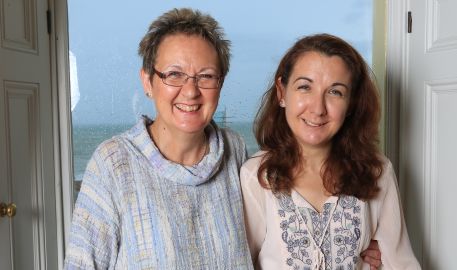Monday – Friday 9am to 5pm
Surgery for degenerative scoliosis
Adults with scoliosis are sometimes offered surgery because of the pain caused by the deterioration of the spine and discs in adult life. Although surgery is more complicated for older people, it is by no means out of the question. Your specialist will be able to advise you on what is the best option.
There are two kinds of degenerative scoliosis, scoliosis that started during childhood or teenage years and continues to get worse when the patient is an adult.
The other type is scoliosis that happens when a person is in their 50s or older. The curve usually develops in the lumbar spine (lower back) and is often shorter and less severe than in scoliosis that occurs during childhood or adolescence. The second type of degenerative scoliosis (also known as de novo) tends to develop because of uneven wear and tear of the discs, causing twisting of the spine and a side curvature.
Discs are a part of the spine. They are round and flat on the top and bottom and are slightly flexible. They stop your vertebrae from rubbing against one another. They also work like shock absorbers for the spine.
Injury to, or degeneration of, discs can lead to lower back pain and leg pain and can also cause numbness and weakness.
Adults with scoliosis are sometimes offered surgery because of the pain caused by the deterioration of the spine and discs in adult life. Although surgery is more complicated for older people, it is by no means out of the question. Your specialist will be able to advise you on what is the best option.
Surgery might not be possible for a patient with osteoporosis (a condition that causes bones to become weak and fragile). Your surgeon may request a bone density scan to check whether your bones are strong enough.
Advice that surgery is recommended can come as a shock for the patient. Shock can make it difficult to think clearly when you are in the consultation room with the specialist. It is a good idea to take someone with you for moral support and so they can help you to remember what was said. Sometimes questions come to mind after the consultation. The best thing to do is to write down these questions, which will help you to remember to bring them up the next time you see the specialist. You can also call or email SAUK for support and advice.
Surgery for adults with degenerative scoliosis that developed as adults
People with scoliosis are sometimes offered surgery because of the pain caused by trapped nerves called spinal stenosis. Freeing up the trapped nerves requires bone to be removed, which in turn can cause the curvature to become worse.
Options to treat spinal stenosis are decompression (removal of bone to free up nerves) or decompression plus spinal fusion on a short or longer section of the spine. Fusion of long sections of the spine is complicated and can be risky because bone is less likely to heal as we get older.
Surgery for adult patients with adolescent idiopathic scoliosis (AIS)
AIS is when the scoliosis developed during growth. The patient may not have been offered treatment or decided against surgery at the time. Sometimes patients seek help when they are adults because of pain or the curve getting bigger. Surgery for young adults with scoliosis has low complications rates compared with patients having surgery for
degenerative scoliosis. The curve will become stiffer with time and a good result is more difficult to achieve as the patient becomes older.
Spinal fusion
Scoliosis surgery is complicated and should only be done by surgeons who are scoliosis specialists. It is major surgery that takes many hours and involves risks. Patients should make sure that they are seeing a scoliosis specialist. You can find out who the scoliosis specialists are by calling or emailing the SAUK office. There are around 30 scoliosis centres across the UK and the Republic of Ireland.
The safety and welfare of the patient is the most important thing for a scoliosis specialist. It is very unlikely that surgery would be recommended if the risks were too great.
Most surgery is done from the back (posterior). Sometimes the surgeon will operate from the side (lateral surgery) or the front (anterior surgery). For very large, stiff curves they might operate from both the back and the side.
Spinal fusion uses metal implants (screws, wires, and/ or hooks) that are attached to the vertebrae (the small bones that make up the spine) and then connected to 2 rods. During the operation, bone graft is placed over the implants. Over a period of about 12 months the bone graft fuses (grows together) with the existing bone in your spine and forms a solid column of bone in that area. The implants and rods hold the spine in place until it is fused. They are not usually removed.
You may lose some flexibility where your spine has fused. However, a lot of the bending we do is from the hips, and lots of people report very little change to how they can move after the operation. How much flexibility you have depends on how much of your spine is fused.
It is very important that patients have as full an understanding as possible of what will happen, both before and after surgery. Knowing what to expect will help to lessen anxiety and stress. The patient is usually in hospital for more than 10 days after the operation.
Aftercare
Once you are home you can gradually start to move more. Because this is a big operation, you will feel very tired, and will need to build up your strength slowly.
On returning home you will need someone to help you to cook, clean, bath, shop, and do other everyday activities because at first these tasks will be hard.
People who are older or frail may need constant care and attention for 6 to 8 weeks.
Patients can usually return to work and light exercise around 3 months after surgery and can be back to normal activity by around 6 months. It will be longer before you can do sports and activities that can jar the back such as horse riding or contact sports like football. You will need to check with your specialist when it is safe to do so.
These timescales are only a rough guide. Patients should remember that there is no set timetable for recovery. Surgery affects people in different ways so one person’s experience will not be the same as another’s. Recovery takes time. On average, it takes 9 months to a year for the fusion to heal, and 12 to 18 months for the patient to recover fully.
You will usually have an outpatient follow-up appointment about 6 weeks after surgery and then again 3 – 6 months after that.
If you would like to talk further about any aspect of scoliosis, SAUK is here to help; please call our helpline or contact us via post or using our e-mail address info@sauk.org.uk.
© 2024 Scoliosis Support & Research | Scoliosis Support & Research is a registered charity no. 1181463
Website design & development by Pedalo

